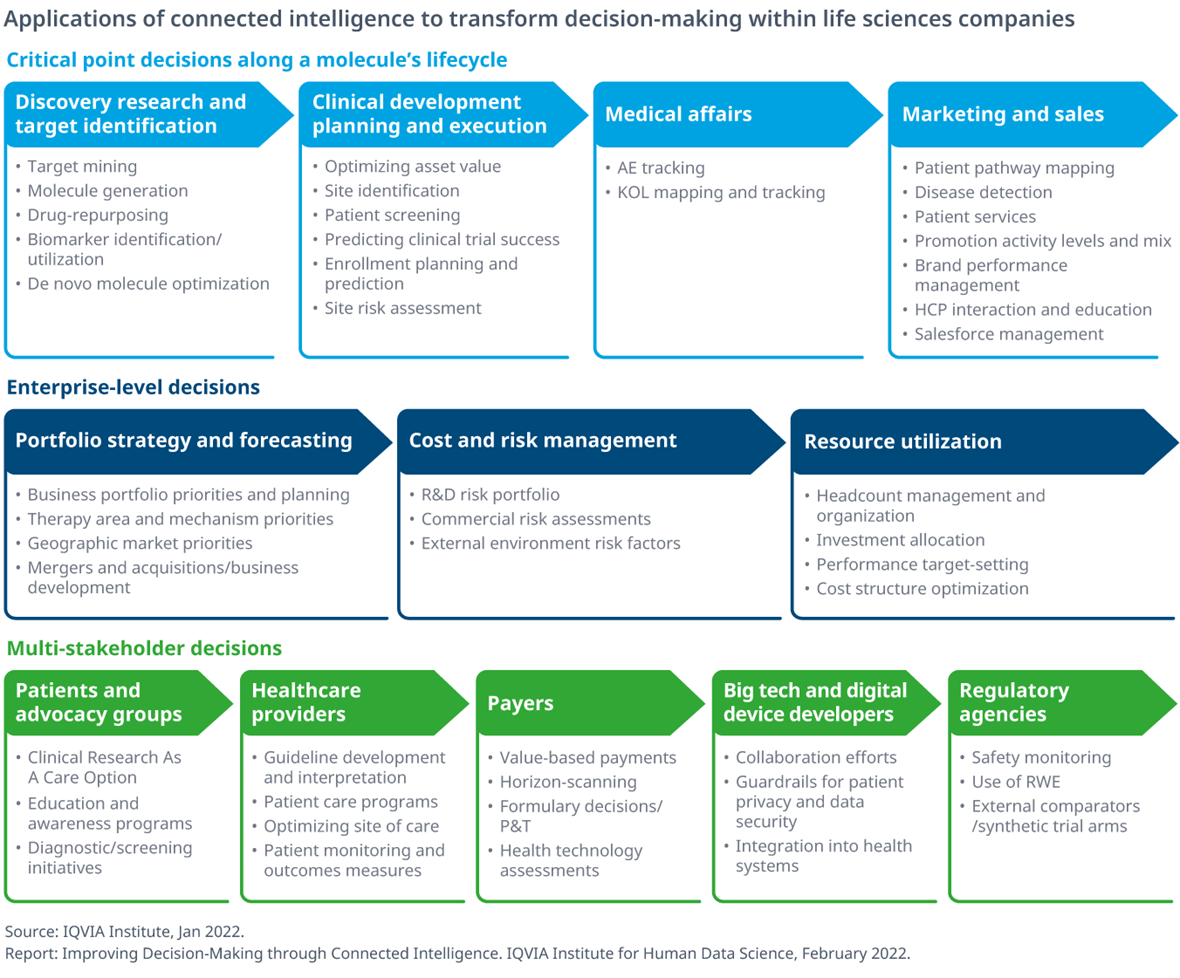Combine data science, technology, and analytics driven by artificial intelligence to support new efficiencies and business insights -- without additional capital investment.






















- Insights
- The IQVIA Institute
- Reports and Publications
- Reports
- Improving Decision-Making through Connected Intelligence
Web Summary
Life sciences companies – key contributors to the healthcare ecosystem – are challenged to evolve continually by obtaining new skills, building new technology systems, and delivering more value to patients and other stakeholders, all while acting more efficiently and rapidly. Every few years, changes in the healthcare ecosystem drive a new set of needs. The impact of advancements in human science, technology, and data science, combined with the impact of the pandemic, have increased the urgency of this transformation, and have made a new set of competencies — that of connected intelligence — essential.
This report – Improving Decision-Making through Connected Intelligence: Leveraging New Capabilities to Help Life Sciences Companies Advance Health – examines the fundamental elements of connected intelligence that feed into decision-making at life sciences companies: building meaningful connections in data and technology, elevating skills to generate insights, and shaping the organizational structure and culture to share, link and utilize those insights. With an eye to what lies ahead for life sciences organizations, the report examines how connected intelligence can generate better insights to guide decision-making at various levels, including at critical points along a molecule’s lifecycle and at the enterprise level, and can enable evidence-sharing and dissemination in support of multi-stakeholder decisions.
Key findings
- Changes within the healthcare ecosystem are shifting the needs of stakeholders and leading to a series of internal transformations within life sciences companies to help them adapt and deliver.
- Advancements in human science, technology and data science are already transforming the way healthcare and life sciences organizations conduct business.
- Stakeholders now have access to more diverse sources of data that can help guide them at a range of critical decision-points in healthcare — both for medical and commercial decisions.
- An evolving capacity — known as connected intelligence — offers to yield new insights, drive smarter decision-making, and enable insight-sharing and partnerships among stakeholders.
- Connected intelligence can improve critical business decisions made at specific points across a molecule’s lifecycle, at the enterprise level, and can provide evidence to guide collaboration with external stakeholders.
Other findings
Several key elements are needed to support connected intelligence within a company:- Data: Underlying the ability for an organization to demonstrate connected intelligence is having access to coherent raw data across a variety of data types and being able to break down internal data silos between these data sources.
- Technology: Enterprise technology is at once the product of connected intelligence and the enabling foundation that accelerates the use of connected intelligence throughout the organization. The quality of a company’s technology, particularly its analytic platforms, is what enables it to bring value from data to the organization through insight generation.
- Skills and capabilities: An organization’s skills and capabilities strongly feed into its ability to apply and benefit from connected intelligence. A company needs to tap into key talent across a variety of roles in order to know what to do with the data and ensure it makes sense for healthcare, select the right data for the right purpose, put needed technology systems in place, and appropriately generate and disseminate insights across the full organization and to stakeholders.
- Insight generation and dissemination: Once a company has invested to get the most value from its data via technology, it can gain a competitive edge through the approaches and actions it takes to operationalize that value internally and externally by structuring those insights and disseminating them throughout the company and beyond to stakeholders.
- Organizational structure and culture: Effective action within an organization requires internal alignment and connection — both to aggressively identify where change, insights and action are needed in response to the new connected intelligence ecosystem, and to ensure that action is taken based on the insights generated.

- Through AI & ML, companies have been able to select investigators and countries for their clinical trials and predict their performance, find HCPs treating patients at risk of disease or undiagnosed, leverage natural language processing (NLP) that enables valuable information to be synthesized from documents such as translating clinical trial documents that support regulatory approval, alert trial investigators to outlier laboratory tests and vitals values to act on, guide commercial engagement and strategy, and optimize investments and manage costs, among other applications.
- Multiple advanced machine learning techniques and other non-AI & ML statistical approaches are useful to develop robust and reliable predictive models.
- To successfully develop and deploy AI & ML, life sciences companies must keep in mind the importance of feeding the AI & ML model with quality data, the appropriate selection and function of the model (as in some cases inappropriate selection will fail to produce results), and the need to run simulations on live data to understand outputs before finalizing algorithm rules.

- A molecule’s lifecycle stretches from the discovery phase where targets are identified, through periods of clinical development, regulatory approval, and commercialization. In each of these stages, there are critical point solutions and decisions that can be transformed by applying connected intelligence.
- At the enterprise level, applying connected intelligence to decision-making can help life sciences companies make more informed investment decisions, set development priorities, and manage risk across their multiple assets, such as molecules or scientific platforms, to achieve success.
- Connected intelligence is also enabling data platforms that can integrate multiple custom sources of data and technology tools and models to support portfolio strategy decisions.

There are several key elements required for life sciences companies to reach and maintain a high connected intelligence IQ. A series of diagnostic questions (included in the last chapter of this report report) can help companies assess their current level of connected intelligence capability across the following areas:






